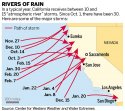Here's something about the next possible reservoir in California. Last one New Melones in Calaveras County was finished in 1979. Construction of Sites Reservoir, located about 70 miles north of Sacramento, would begin in 2025 and be completed by 2029. San Luis Reservoir in Merced County, the largest off-stream reservoir in the USA, can hold 2 million acre-feet of water
http://napavalleyregister.com/eagle...cle_a25c2d0a-c0b5-5366-a214-4ca6925478f2.html
Sites Reservoir has been under discussion by water experts since the 1970s. It calls for creating a large man-made lake near the town of Maxwell that could hold 1.8 million acre feet of water. An acre foot equals nearly 326,000 gallons of water.
About the size of Lake Berryessa, Sites Reservoir would require the building of a dam, pipelines and canals to ferry water to and from the lake. Unlike other large reservoirs in California, such as Lake Oroville, Sites would be an off-stream water source, meaning it would not be created by daming a river.
Some of the states largest water players, from the California Department of Water Resources to the Metropolitan Water District in Los Angeles, are behind the development of Sites Reservoir.









